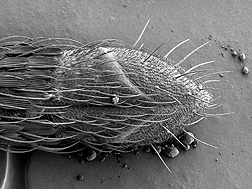Mosquitoes Reveal a Taste for Repellents
The more scientists learn about mosquitoes’ sense of smell and taste, the better they’re able to develop ways to protect us against mosquito bites, which can sometimes transmit dangerous pathogens that cause diseases such as malaria, yellow fever, and West Nile virus.
Previous research has shown that DEET, the most common active ingredient in insect repellents, interacts with the mosquito’s sense-of-smell (olfactory) receptors, located on its antennae and mouthparts. These receptors pick up carbon dioxide and other odors emitted by humans and animals, leading the mosquito to a host.
Recently, Agricultural Research Service scientists in Beltsville, Maryland, showed that insect repellents also affect the mosquito’s sense-of-taste (gustatory) receptors. Entomologist Joseph Dickens and his colleagues in the Invasive Insect Biocontrol and Behavior Laboratory discovered that a taste receptor located on a mosquito mouthpart is sensitive to DEET.
“We know that DEET deters blood feeding by interactions with olfactory receptor cells,” Dickens says. “Mosquitoes become confused and fly away. The fact that DEET is also interacting with a specific taste receptor might indicate that there is a sensory pathway for taste that helps inhibit feeding.”
After discovering that certain nerve cells respond to DEET and other repellents, scientists looked for the receptors responsible for this reaction. Experiments involved recording responses of yellowfever mosquitoes to different insect repellents—DEET, IR3535, picaridin, and citronellal—and a feeding deterrent, quinine.
|
|
At the tip of the mosquito’s “beak”—or proboscis—is a pair of flaps called “labella” that make the first contact with a person’s skin. These flaps have tiny hairs that serve as chemical-sensing organs. Electrodes were placed over a single hair to record electrical impulses from nerve cells within the hair.
“We found that at least three sensory cells were activated in the hair,” Dickens says. “One was sensitive to increasing concentrations of salt—sodium chloride. Another one was sensitive to increasing concentrations of sugar, and another cell was responsive to DEET and quinine.”
Dickens and postdoctoral research associate Jackson Sparks are working to distinguish other receptors located on the mouthparts and legs of mosquitoes and determine their molecular genetic functions. “We’re getting an idea of the specific receptors at a gene level involved in the response to DEET,” Dickens says, “and we have candidate genes that we’re going to examine.”
The research, which was published in Naturwissenschaften in February 2013, has given scientists a better understanding of how mosquito repellents work, and it could help provide methods to uncover novel and improved chemicals to better manage insects and other arthropods.
“DEET works, but it’s only effective at high concentrations,” Dickens says. “Products to keep mosquitoes from biting generally have 20 percent DEET. Some even contain 50 percent or more. We’re trying to discover alternatives that are many times more active than DEET so that less chemical has to be applied to the skin.”—By Sandra Avant, Agricultural Research Service Information Staff.
This research is part of Veterinary, Medical, and Urban Entomology, an ARS national program (#104) described at www.nps.ars.usda.gov.
Joseph Dickens is with the USDA-ARS Invasive Insect Biocontrol and Behavior Laboratory, 10300 Baltimore Ave., Beltsville, MD 20705-2350; (301) 504-8957.
"Mosquitoes Reveal a Taste for Repellents" was published in the August 2014 issue of Agricultural Research magazine.








